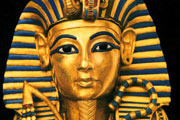What Are Hieroglyphics?
English has 26 characters (called letters) that are made up into words and then into sentences. Ancient Egyptians had more than 2,000 characters, which they called hieroglyphics. Each hieroglyphic is a common object - a reed, an eagle, a basket, water, etc. that represents a letter of their alphabet. Hieroglyphics were the earliest form of writing in Egypt and were basically only used in formal settings. Hieratic was the script used for day-to-day writing.
How Do You Write With Hieroglyphics?
Hieroglyphics were written in rows or columns without spaces and can be read from left to right or from right to left. The symbols (human and animals) always face towards the beginning of the line so you know which direction to start reading. Besides changing direction, hieroglyphics rarely used vowels, although they were spoken. In English, words are often abbreviated by leaving out the vowels - bldg = building, ltd = limited and cm = centimeter. The only time hieroglyphics use vowels is when a word begins with one or if it might be confusing without them.
Where Were Hieroglyphics Used?
You can see hieroglyphics on ancient tombs, pyramid walls, pottery and ceramics. Scribes also used hieroglyphics on papyrus to record the history of Egypt. Hieroglyphics were extremely hard to learn. Only scribes learned to write them and they trained for years, starting school when they were boys. Girls were not allowed to go to school so they couldn't become scribes. Scribes were special royal servants. They didn't have to go into the military or pay taxes. They were also well-respected and had their pictures painted on the walls of houses and monuments.
The Rosetta Stone
Hieroglyphics were a mystery until the Rosetta Stone was uncovered. The three foot tall and two foot wide stone was discovered near the Rosetta mouth of the Nile in 1799. Three different types of script are written on the stone: hieroglyphics, Egyptian Demontic and Greek. It took many years for the stone to be properly deciphered with several linguist scholars working on the task including French-born Sylvestre de Sacy, Englishman Thomas Young and French scholar, Jean Francios Champollion. It was Champollion that finally pieced everything together in 1822. When the British defeated the French in the Battle of the Nile, they claimed the Rosetta Stone and sent it to the British Museum where it still remains to this day.
































